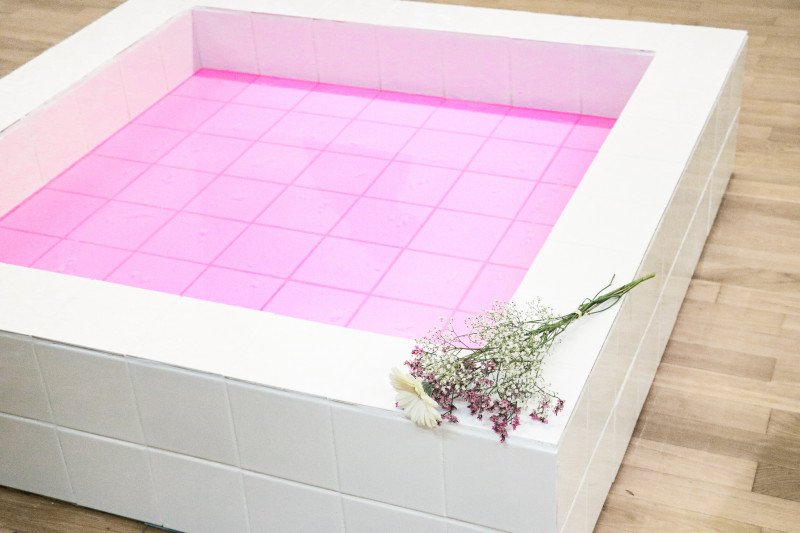
The art exhibition entitled “HEIGH-HO” is dedicated to a critical exploration of the theme of work.
The expression Heigh-Ho, veiled behind the name of the exhibition, is in reality the title of a song from the famous Disney adaptation of the Brothers Grimm fairytale – Snow White and the Seven Dwarfs. Although the film was released in cinemas back in 1937, its influence has endured for almost a hundred years, shaping the perception of labour of countless people around the world. Even today, many children, teenagers and adults worldwide can chirp at least a few lines from the song Heigh-Ho. Nearly everyone knows the seven little dwarfs with their tiny pickaxes, happily singing on their way to (or from) work, while Snow White waits compliantly at home, keeping the cottage in order.
But how does one come to name an exhibition about work after the song from a 1937 Disney film? The title Heigh-Ho represents, perhaps, an outdated form of division of labour and understanding of work. However, it also encompasses the idea behind the exhibition project: examining the working conditions of the recent past and present from a contemporary point of view. Furthermore, this opens up a space to reflect on the impact that the turbulent events of the last two years have had on the perception of one’s working circumstances. The interdisciplinary approach to the topic of work, which this exhibition brings, offers an innovative opportunity to present this problematic subject from different perspectives.
The exhibition explores the transformation in the relationship between the self, body, and work. In addition, the presented artworks focus on different types of labour relations, as well as on the invisibility of work itself. Precarious working conditions are ubiquitous also in Austria, where unions and syndicates still play a significant role. In addition to the precariousness of wage-earning, the neoliberal model of work has also brought about changes in people themselves. The boundaries between employment and leisure are blurring. One falls into a constant cycle of self-improvement and identification with work, which ultimately results in alienation from oneself. The theme of the exhibition is particularly poignant now, at a time of the global pandemic.
For the exhibition Heigh-Ho, curators Anežka Jabůrková and Miljana Mirović have selected twelve artworks by ten artists from six different countries. The oldest work dates from 2007, the most recent from just before the outbreak of the Coronavirus Pandemic. There is a diverse range of media that the respective artists use to convey their concerns. Each of the artworks is dedicated to a different issue connected to the topic of the work.
In the context of the exhibition, both the realities of wage labour in the factory, at home, and in the office are examined, as well as various conditions that shape our experience of work. In her two contributions, Barbora Kleinhamplová thematizes the question of how identification with work influences one’s identity, and where does one, in this context, set a limit to their own flexibility. An answer to this question could be provided by the work of Jana Kapelová. She examines the fine line between work and leisure, distinguishing these often merged contexts. Jiří Skála and Jakub Valenta develop this topic by investigating the possibilities of surveillance and control in the digital space. The fact that the workers themselves are not the only ones responsible for making the distinction between work and leisure is shown by Zbyněk Baladrán, who is concerned with the mechanisms of performance optimization in the corporate sphere. The environment of large corporations is also a topic of interest of the artists Anna Witt and Burak Delier. Witt is focused on the experiences and perceptions of power distribution in the workplace, while Delier explores the mechanisms of adaptation to the requirements of one’s work environment.
As a transition to the topic of “care work,” we can see the work of Jiří Skála addressing the recognition and valuation of the workforce. The issues connected to care work are addressed by the works of artists Katarína Csányiová, Jelena Micić, and Karin Maria Pfeifer. Csányiová examines how precarious working conditions affect the lives of cross-border workers who practise their professions outside the legal systems of their respective countries. Micić addresses both the issue of undocumented workers and the disregard for health measures in precarious employment. Pfeifer draws the viewer’s attention to everyday objects, commenting on the relationship between the intimate setting of domestic work and the conditions under which workers perform the same activities, to earn a living.
Artists: Zbyněk Baladrán, Katarína Csányiová, Burak Delier, Jana Kapelová, Barbora Kleinhamplová, Jelena Micić, Karin Maria Pfeifer, Jiří Skála, Jakub Valenta, Anna Witt
Curators: Anežka Jabůrková, Miljana Mirović
Graphics designer: Kristýna Jordánová
Technical production: Pavel Matěj
Eintritt frei!